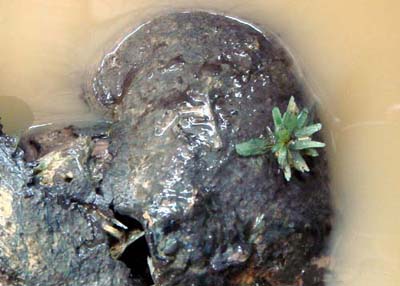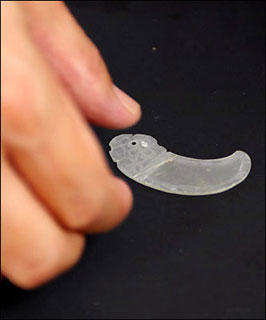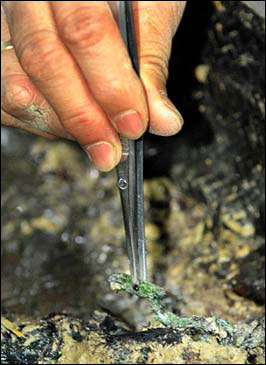| Tools: Save | Print | E-mail | Most Read |
| Rare Green Crystals Found in Jiangxi Tomb |
| Adjust font size: |
Chinese archaeologists exploring a 2,500-year-old tomb in east China's Jiangxi Province were stunned to discover several pieces of green crystal lodged in the bones of the skeletons in the coffins. One of the diamond-shaped crystals was 8.5 centimeters long.
The coffins also contained bronze, gold, silk, porcelain, and jade items and even body tissue. Archaeologists said the crystals appeared to have "grown" in the bones. They pointed out that the coffins were made from halved nanmu, a rare and extremely durable wood, and covered in white plaster and a layer of loess. The fact that the coffins were fire-heated to make them waterproof and airtight may be a factor in the creation of the crystals. Classically, crystals are formed when rocks are heated and then cool slowly over time. Archaeologists said there were no previous records of green-colored crystals being found in tombs and said they would help scientists understand changes to the human body in different conditions. According to Wang Yarong, an academic with the Chinese Academy of Social Sciences, a few white crystals were found in the Mawangdui Western Han Tombs (206 B. C.- 24) in central China's Changsha, capital of Hunan province. Researchers said they were the result of crystallization of amino acids. Discovered in December 2006, the tomb in Lijia village in Jing'an County, Jiangxi is 16 meters long, about 11.5 meters wide and three meters deep. It is believed to date back to the Eastern Zhou Dynasty (770-221 B.C.). This is the largest group of coffins ever discovered in a single tomb in China, prompting cultural experts to dub the excavation "the most important archaeology project of the year." Scientists say that the body tissue discovered in the coffins are human brains that have shrunk to the size of a fist but retained their original structure complete with two cerebral hemispheres, cerebellum, and brainstem. "This is the first time such complete old brain structures have been found in southern China and they will be extremely useful for the study of humans in the pre-Qin era (770-221 BC)," said Zhu Hong, a paleoanthropological expert from Jilin University. Zhu said the unique burial style could explain why the skeleton and the brain tissue had been preserved so well in an area where the soil was acidic and unsuited to the preservation of human bodies. The coffins, 2.5 to 2.8 meters long and 0.5 meters wide, were laid out side by side in an orderly fashion. Thirteen of the coffins have now been transferred to a nearby storehouse to be kept in a temperature and humidity-controlled environment. The main coffin, weighing more than a ton, was opened at about 10 AM Monday. Archaeologists found a round, exquisitely made piece of gold foil as well as a jade pendant in the shape of a dragon. Experts believe the two treasured decorative items could be symbols of the dead person's social status or political power. In another coffin, archaeologists found a beautifully preserved skeleton lying on its right side. "The coffins were tightly sealed and there was very little oxygen in there for bacteria to reproduce. This may explain why most of the skeletons are intact," said Zhu. The discovery will provide valuable clues to the study of social customs, funeral rites, and lifestyles in the area 2,500 years ago, experts said.
(Xinhua News Agency July 5, 2007) |
| Tools: Save | Print | E-mail | Most Read |
 |
| Related Stories |



